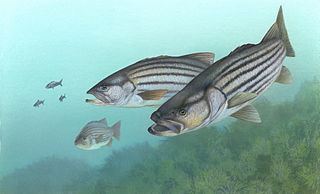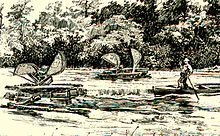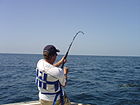
Trout is a generic common name for numerous species of carnivorous freshwater ray-finned fishes belonging to the genera Oncorhynchus, Salmo and Salvelinus, all of which are members of the subfamily Salmoninae in the family Salmonidae. The word trout is also used for some similar-shaped but non-salmonid fish, such as the spotted seatrout/speckled trout.

The striped bass, also called the Atlantic striped bass, striper, linesider, rock, or rockfish, is an anadromous perciform fish of the family Moronidae found primarily along the Atlantic coast of North America. It has also been widely introduced into inland recreational fisheries across the United States. Striped bass found in the Gulf of Mexico are a separate strain referred to as Gulf Coast striped bass.

The smallmouth bass is a species of freshwater fish in the sunfish family (Centrarchidae) of the order Perciformes. It is the type species of its genus Micropterus, and is a popular game fish sought by anglers throughout the temperate zones of North America, and has been spread by stocking—as well as illegal introductions—to many cool-water tributaries and lakes in Canada and more so introduced in the United States. The maximum recorded size is approximately 27 inches (69 cm) and 12 pounds (5.4 kg).

The largemouth bass is a carnivorous freshwater ray-finned fish in the Centrarchidae (sunfish) family, native to the eastern and central United States, southeastern Canada and northern Mexico. It is known by a variety of regional names, such as the widemouth bass, bigmouth bass, black bass, bucketmouth, largie, Potter's fish, Florida bass, Florida largemouth, green bass, bucketmouth bass, green trout, Gilsdorf bass, Oswego bass, LMB, and southern largemouth and northern largemouth.

Bass fishing is the recreational fishing activity, typically via rod-based angling, for various game fishes of North America known collectively as black bass. There are numerous black bass species targeted in North America, including largemouth bass, smallmouth bass, spotted bass or Kentucky bass, and Guadalupe bass. All black bass species are members of the sunfish family Centrarchidae.

Jigging is the practice of fishing with a jig, a type of weighted fishing lure. A jig consists of a heavy metal sinker with an attached fish hook that is usually obscured inside a soft lure or feather-like decorations. Jigs are intended to create a jerky, vertical "jumping" motion to attract fish, as opposed to other common lures like swimbaits, spoons and spinnerbaits, which move through the water more or less horizontally. The jig is very versatile and can be used in both salt and fresh water. Many deeper water fish species are attracted to the lure, which has made it popular among anglers for years.

The Guadalupe bass is a rare species of fish endemic to the U.S. state of Texas, where it also is the official state fish. It is restricted to creeks and rivers, and is listed as near threatened. Today, most fly fishermen and anglers practice catch-and-release techniques to improve fish populations. The Guadalupe bass is often difficult to distinguish from the smallmouth bass or spotted bass, and the fish is known to hybridize.

The American shad is a species of anadromous clupeid fish naturally distributed on the North American coast of the North Atlantic, from Newfoundland to Florida, and as an introduced species on the North Pacific coast. The American shad is not closely related to the other North American shads. Rather, it seems to form a lineage that diverged from a common ancestor of the European taxa before these diversified.

Alosa is a genus of fish, the river herrings, in the family Clupeidae. Along with other genera in the subfamily Alosinae, they are generally known as shads. They are distinct from other herrings by having a deeper body and spawning in rivers. Several species can be found on both sides of the Atlantic Ocean and the Mediterranean Sea. Also, several taxa occur in the brackish-water Caspian Sea and the Black Sea basin. Many are found in fresh water during spawning and some are only found in landlocked fresh water.

The Atlantic Spanish mackerel is a migratory species of mackerel that swims to the northern Gulf of Mexico in spring, returns to southern Florida in the eastern Gulf, and to Mexico in the western Gulf in the fall.

The skipjack herring is a North American, migratory, fresh- and brackish water fish species in the herring family Clupeidae. The name skipjack shad comes from the fact that it is commonly seen leaping out of the water while feeding. Other common names include blue herring, golden shad, river shad, Tennessee tarpon, and McKinley shad. The skipjack shad is restricted to the Gulf of Mexico drainage basins. Skipjack are found in clear to moderately turbid water in areas with flow. Because they are a migratory species, dams often impede their reproduction. Records suggest that this species was much more abundant in the Upper Mississippi River basin before it was impounded. Currently, skipjack is most abundant in the Upper Mississippi River below the mouth of the Ohio River. They are known as an "early-run" species as they migrate to spawn in the early spring.
The hickory shad, fall herring, mattowacca, freshwater taylor or bonejack is a member of the herring family Clupeidae, ranging along the East Coast of the United States from Florida to the Gulf of Maine. It is an anadromous fish species, meaning that it spawns in freshwater portions of rivers, but spends most of its life at sea. It is subject to fishing, both historic and current, but it is often confused with or simply grouped together with American shad in catch statistics.

The twait shad or twaite shad is a species of fish in the family Clupeidae. It is found in the eastern Atlantic Ocean and the Mediterranean Sea and is an anadromous fish which lives in the sea but migrates into fresh water to spawn. In appearance it resembles an Atlantic herring but has a row of six to ten distinctive spots on its silvery flanks. They become mature when three or more years old and migrate to estuaries, later swimming up rivers to spawn. Populations of this fish have declined due to overfishing, pollution and habitat destruction. Conservation of this species is covered by Appendix III of the Bern Convention and Appendix II and V of the European Community Habitats Directive.

Striped bass are perciform fish found all along the Atlantic coast, from Florida to Nova Scotia. A distinct strain has historically existed in the Gulf of Mexico, but the fishery that exists there today is for stocked or reservoir-escapee fish. Striped bass are of significant value as sporting fish, and have been introduced to many areas outside their native range.
This page is a list of fishing topics.
The following outline is provided as an overview of and topical guide to fishing:

Fishing for walleye is a popular sport with anglers. The current IGFA all tackle record is 11.34 kilograms, caught on August 2, 1960 in Old Hickory Lake, Tennessee.

Mahi-mahi are swift and acrobatic game fish with striking colours. These colours darken when the fish dies The current IGFA all tackle record is 39.91 kilograms (88lb), caught in 1998 in Exuma, Bahamas by Chris Johnson of Lake Mary, Florida. Catches average 7 to 13 kilograms, and any mahi-mahi over 18 kilograms (40 lb) is exceptional. Males are often larger than females.

The Pontic shad, also referred to as the Black Sea shad or Kerch shad, is a species of clupeid fish in the genus Alosa, native to the Black Sea and Sea of Azov basins.

The Alabama shad is an anadromous species of clupeid fish endemic to the United States where it breeds in medium to large flowing rivers from the Mississippi River drainage to the Suwannee River, Florida, as well as some other Gulf coast drainages. The biology of this fish is little known but it has become increasingly rare. The International Union for Conservation of Nature rated it "near threatened" in 2020 and the United States National Marine Fisheries Service has listed it as a Species of Concern. A principal reason for its decline is thought to be the many locks and dams blocking access for the fish to up-river spawning grounds.






















